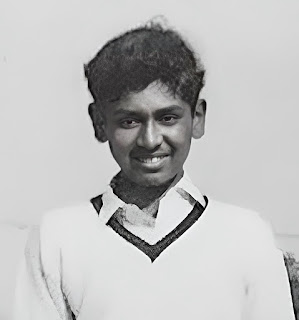1950s speed skating in the gym at Charney was not a sport, more a means of working off excess energy in the long winter evenings. There were no helmets, knee/arm protectors or gloves then, just rudimentary steel wheeled skates on which we rolled in never ending anti-clockwise direction over the rutted pine floor boards at ever increasing speed.
The noise of wheels on wood and clamour of boys shouting was deafening and could be heard outside in the small courtyard.
Skates which cost our parents over £1-10s, were adjustable in length by means of a bolted slider and had metal clips which gripped the sole at the toe of the shoe. The back of the skate was held tightly around the ankle with a leather strap. To buy a pair today might cost over £50 which considering the simplicity of the manufactured item appears to be very expensive.
Some floor boards were splittered and the polished steel floor brads projected above the undulating surface creating an additional hazard. Woe betide any boy who lost his balance and fell - both bottom and hands were at risk!
Round and round we would go - faster and faster. It was both hypnotic and addictive and gave a feeling of freedom and great speed, especially on the corners when it was necessary, in order to avoid falling or hitting the end wall, to lean into the bend, knees bent and body over to counteract the centrifugal force. If you had sufficient confidence, crossing the legs on the bends would maintain speed otherewise it was a case of free-wheeling around to the back straight.
Bending forwards and swinging the arms
on the straights increased momentum.
The appearance of rubber wheeled skates sometime in the mid-50s caught on very quickly. The wheels were fitted with ball bearings and were much smoother running, quieter and must have been a great relief to masters relaxing in the Common Room. They were sometimes fitted with a rubber ‘brake’ under the front of the skate which could also be used for gaining purchase at a standing start.
Despite the immense popularity of this pastime I can’t remember any serious skating accidents in the Gym. It is surprising as, although Messrs. Fawcett or McCullagh would occasionally appear around the door to check us out, we were really left to our own devices.
The article below identifies the hapless inventor and the most probable date for the appearance of the roller skate. It also illustrates the potential danger which could befall the feckless and unwary....!
LONDON’S SMASHING ENTRANCE TO ROLLER SKATINg
Some say it happened in 1775, others say it was in the 1760s and some say it took place at a London stage performance, whilst others maintain it was a party held at the inventor’s home. Yet another source has it at a masquerade ball hosted by one of London’s flamboyant females, the infamous Mrs Cornelys of Carlisle House, Soho Square.
The story goes that a mechanic and maker of musical instruments by the name of John Joseph Merlin born in Huys, Belgium, in September 1735, moved to London in May 1770 as the director of Cox’s Museum in Spring Gardens. Notably, he exhibited a number of his pet projects: an organ, a piano and a harpsichord. Merlin also had examples of his work in his home on Oxford Street (affectionately known as Merlin’s Cave), where he displayed his unique invention, yes indeed, the roller skate.
Wherever it was that Merlin made his historic debut, he did so on his ‘metal wheeled-boots’. Again, others described them as a pair of black, wooden-braced, forty-pound wheeled boots that allowed him to move over the hardwood floor as if it were ice. Adding extra display to his entrance, he did so while playing his fiddle. A news piece of the day says this is how it was received:
“One of his ingenious novelties was a pair of skates contrived to run on small metallic wheels. Supplied with a pair of skates and a violin he mixed in the motley group of one of the celebrated Mrs Cornelys’ masquerades at Carlisle House, Soho Square; when not having provided the means of retarding his velocity or commanding his direction, he impelled himself against a mirror of more than 500 Pounds value, dashed it to atoms, broke his instrument to pieces and wounded himself severely.”
The mention of him being severely wounded alludes to the fact that he nearly lost his arm, which would have put pay to his fiddling days. What this did do was send roller skating back to the drawing board and the world of roller skates went quiet.









Comments